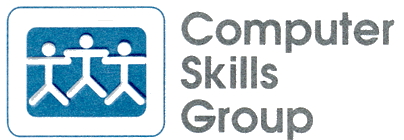

Last week, I wrote about organizing your desktop icons to where they can be neatly grouped in alphabetical order, hopefully making them easier to find. Expanding on that tip, I would like to introduce "The "Skills Group Method". The Skills Group Method is a coordinated approach to organizing your computer. It uses only standard Windows features, but suggests using them in a coordinated way aimed at ease of use. The worst thing that will happen here is that you will read about how to do this and learn a little more about Windows. I encourage you to try the whole concept though. I think you'll find it very handy. And remember, Computer Skills Group takes phone calls as part of its service. If you want to discuss this tip, just pick up the phone.
Here's the idea -
The idea is to put things where you can get to them, when you need them.
Who's got the better approach, Microsoft or Apple?
The Windows "desktop" concept is based on having ten, twenty, or fifty "things" on top of your desk at all times, forcing you to search through them when you need to find something.
It is supposed to look like a cluttered desk, and I see three problems with this concept.
Now I know that Microsoft has always shown Windows desktops covered with icons, but if you've ever looked at the Apple Computer operating system, commonly acknowledged to be to "more user friendly", you know they do it differently.
Instead of cluttering their desktop, Apple leaves it uncluttered but reserves a line on the bottom of the screen to hold all that stuff (technical term ![]() ).
It's an improvement, but both approaches have their shortcomings.
Apple's problem is that they run out of room for all the icons and have to use a trick to make them bigger when you want to see what the icon really is!
).
It's an improvement, but both approaches have their shortcomings.
Apple's problem is that they run out of room for all the icons and have to use a trick to make them bigger when you want to see what the icon really is!
We can do better than both -
Ask yourself this: What is the one thing you can always see, like right now for example?
Correct.
It's the Start button.
The Skills Group Method says, put things where you can get to them when you need them.
I am suggesting that you put your desktop content on the Start button, instead of on the desktop.
No, I didn't waste your time last week, having you organize your desktop.
Read on and you'll see why.
First, here's a note for Windows XP and Windows 2000 users only. I am strongly suggesting that you elect to use the "Classic Start Menu" option for your computer. For space and time considerations, I will not go into the reasons here, but simply say that the XP concept is terrible by comparison. If you are using it, switch back to the "Classic" version. To change it, click on Start, Control Panel, Taskbar and Start Menu, and the Start Menu tab.
Here's what we want to do -
The classic Start button pops open a menu that is divided by horizontal lines into three sections.
The lowest section has your logoff/shutdown options.
The next section up contains various common options, the most notable being Run, Help, Search (or Find), Settings, and Programs.
The top section is often completely ignored by users, but it is the one we care about here.
What we are going to do in the top section is to remove anything we don't want, add what we do want, and organize these items by renaming and alphabetizing them.
Don't panic.
This is done VERY easily and quickly, especially if you did what I suggested in last week's tip (a reward!!!).
And . . . here's how we do it -
All these steps assume that you clicked on Start to open the menu and that you are working on the very top section of the menu.
Most of you are done at this point. Only read the following if your new menu is too large to fit on the screen without scrolling to see it all.
That's it, but what if your new menu has too many items to fit on one screen? Windows gives you some little arrows to show that you can scroll the menu up or down to see the additional items. I personally don't care for that and there are two things you can do to fix it.